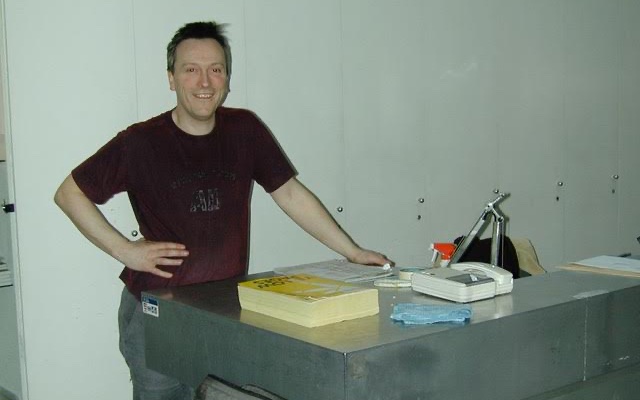Keith Watson RIP
Keith Watson Sadly Died May 5th 2023
Remembering Keith Watson
By James Faure Walker
I first met Keith in the mid nineties, at the Private View of a London Group Exhibition. I was showing a digital print - photos of tourists in Leicester Square blended into a grid. We got talking. When he said that he and a colleague were opening a gallery showing digital art, I was all ears. I wanted to be part of it. The Colville Place Gallery opened in Fitzrovia, just off Tottenham Court Road, in 1997.
Computer art – as it was then called – was not something you would find in an art gallery. It was considered gimmicky, without the resonance of real art. The ‘print-out’ would soon fade. I had shown a few pieces here and there, but eyes would glaze over at the mention of ‘computer’. Keith was not an art world person, and that turned out to be an advantage. He would look at what digital artists were doing with an open mind.
Keith had been a student at the London College of Printing, and for thirteen years had worked as a graphic designer. He was completely at home manipulating images on a screen. In art schools, fine art and graphics were kept at arms length. My initiation came from infiltrating the Graphics Department at St Martins. They had an annexe in Long Acre, their computer centre. I was teaching in the Painting Department. I was amazed at what they could do there – and in colour! Over the 1988 Easter holidays they generously leant me an Apple II plus a printer. I had chatted with John Landsdown there, but my interest was in painting more than in programming. I just wanted to tumble the colours about.
In 1999 Keith was joined at Colville Place by a new gallery partner. Wolfgang Lieser was running his gallery in Wiesbaden, and had become a champion of digital art. He created the Digital Art Museum, documenting the history, going back to the pioneers of the sixties. Mike King, who also showed at the Colville, constructed the DAM website in 2000. The DAM Gallery continues to be a success in Berlin.
Despite slender resources, Keith and Wolfgang put the Colville Place Gallery on the international map, but this never translated into sales. Roman Verostko and Joan Truckenbrod were among many others who showed there. There were offshoots in venues that included the Global Café in Golden Square, the upmarket Soho House, a club in Paris, and the Frankfurt Art Fair. After the gallery closed Keith took over the space that had been the Lux Gallery in Hoxton Square – the centre of the YBA art world - and ran it as the Deluxe Gallery. This venture came to an abrupt end when a powerful New York dealer expressed an interest in taking over the space.
Digital art had morphed into ‘new media’, which included web art, virtual reality, and interactive installations. Two-dimensional works needed a quiet space. SIGGRAPH art shows had become closer to multimedia light shows. But the newer formats did not lead to better sales. It wasn’t a surprise to find Keith working for Kinetica, the organisation promoting kinetic art exhibitions. From 2009 to 2014 Kinetica filled the vast P3 basement of the University of Westminster every February with a baroque medley of spinning illusions, jerky robots, and dancing sculpture. There were long queues. These shows were absolutely packed.
Keith took on his role as Public Art Officer at Canary Wharf in 2008 at the same time as working on Kinetica. His role involved installing sculpture and other static work. Keith invited artists to fill a small ‘window gallery’ opposite Waitrose. Five visitors a day at the Colville would have been impressive, but here the footfall was in the thousands. The audience may have strolled past the art – they were thinking of lunch or shopping – but you never knew what might get through. Showing in public spaces is an education for the artist, and through Keith you could find unexpected uses for an artwork. There was an interdenominational chapel off the mall, and they required a non-controversial picture. Why a chapel, I asked? Apparently, now and then someone had a meltdown, and this was a safe place to calm down. That week there had been a streaker down the mall. Amidst all the corporate architecture, all the consumerism, there were fragile humans. Keith, always personable and sensitive, identified places where art could come into its own, from a recovery chapel to the vast Light Festival.
From the start Keith was an enthusiast. His optimism made things happen. It kept him going through occasional setbacks. Keith always had a sense of fun. Early on at Colville Place he got hold of a Sony robotic dog. In a recent interview, he was typically self-effacing. Looking back over the twenty-five years between starting the Colville Place Gallery, and running the Winter Lights Festival at Canary Wharf, he spoke as though he was just following trends, catching up with digital art as it evolved. He did much more than that. In his quiet way, working behind the scenes, he made it possible for scores of artists to show their work. The story of digital art in London would have been different had he not been around.
